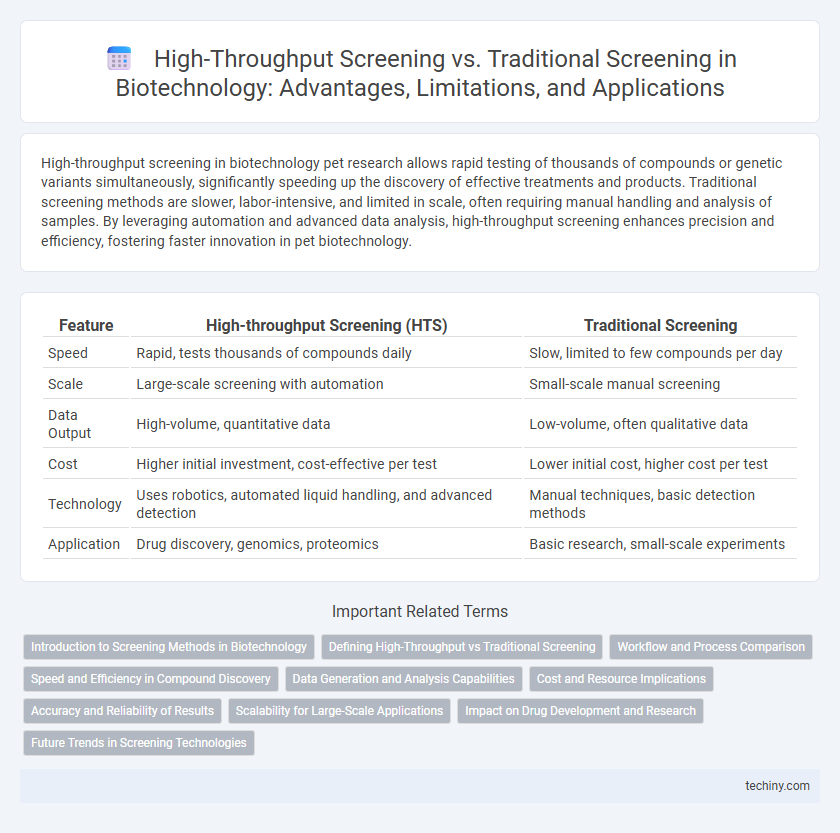High-throughput screening in biotechnology pet research allows rapid testing of thousands of compounds or genetic variants simultaneously, significantly speeding up the discovery of effective treatments and products. Traditional screening methods are slower, labor-intensive, and limited in scale, often requiring manual handling and analysis of samples. By leveraging automation and advanced data analysis, high-throughput screening enhances precision and efficiency, fostering faster innovation in pet biotechnology.
Table of Comparison
| Feature | High-throughput Screening (HTS) | Traditional Screening |
|---|---|---|
| Speed | Rapid, tests thousands of compounds daily | Slow, limited to few compounds per day |
| Scale | Large-scale screening with automation | Small-scale manual screening |
| Data Output | High-volume, quantitative data | Low-volume, often qualitative data |
| Cost | Higher initial investment, cost-effective per test | Lower initial cost, higher cost per test |
| Technology | Uses robotics, automated liquid handling, and advanced detection | Manual techniques, basic detection methods |
| Application | Drug discovery, genomics, proteomics | Basic research, small-scale experiments |
Introduction to Screening Methods in Biotechnology
High-throughput screening (HTS) enables rapid evaluation of thousands to millions of biological samples using automated robotics, data processing, and sensitive detection technologies, significantly accelerating drug discovery and genetic research. Traditional screening methods involve manual, time-consuming processes with limited sample throughput, which can delay the identification of active compounds or gene functions. HTS improves efficiency and scalability by integrating automated liquid handling, microplate readers, and bioinformatics tools to analyze complex biological interactions in diverse chemical libraries.
Defining High-Throughput vs Traditional Screening
High-throughput screening (HTS) is an automated process that rapidly tests thousands to millions of compounds for biological activity using robotics, data processing, and sensitive detectors, enabling efficient drug discovery and target identification. Traditional screening relies on manual or low-throughput assays, analyzing fewer samples with longer assay times and limited automation. HTS maximizes scalability and throughput, while traditional methods emphasize detailed, customized analysis with slower experimental cycles.
Workflow and Process Comparison
High-throughput screening (HTS) streamlines the drug discovery process by automating and miniaturizing assays, allowing the rapid testing of thousands to millions of compounds simultaneously. Traditional screening involves manual, slower procedures with limited throughput, often testing one compound or a small set at a time, leading to increased time and labor costs. HTS enhances workflow efficiency by integrating robotics, data analysis software, and microplate formats, drastically reducing assay time and improving reproducibility compared to the sequential and labor-intensive traditional screening methods.
Speed and Efficiency in Compound Discovery
High-throughput screening (HTS) revolutionizes compound discovery by enabling the rapid testing of thousands to millions of compounds against biological targets using automated robotics and sophisticated data analysis, vastly outperforming traditional screening methods, which rely on manual, low-throughput assays. HTS significantly accelerates the identification of active compounds by increasing the screening speed from weeks or months to days, while enhancing efficiency through miniaturized, multiplexed assays that reduce reagent use and cost. This advancement in screening technology streamlines drug discovery pipelines, enabling faster progression from hit identification to lead optimization.
Data Generation and Analysis Capabilities
High-throughput screening (HTS) generates vast datasets rapidly by testing thousands of compounds simultaneously, leveraging automated robotics and advanced imaging technologies. In contrast, traditional screening produces smaller, manually curated datasets, limiting the scale and speed of data acquisition. HTS enables more comprehensive data analysis through integrated bioinformatics tools, enhancing the identification of lead compounds and accelerating drug discovery.
Cost and Resource Implications
High-throughput screening (HTS) significantly reduces per-sample cost by automating the testing of thousands of compounds simultaneously, contrasting with traditional screening's labor-intensive manual processes that demand higher labor and consumable expenses. HTS leverages robotics, miniaturized assays, and advanced data analytics, resulting in lower reagent volumes and faster turnaround times, thereby optimizing resource utilization. Although initial infrastructure investment for HTS is substantial, the long-term savings in operational costs and enhanced screening efficiency make it more cost-effective than traditional methods.
Accuracy and Reliability of Results
High-throughput screening (HTS) significantly enhances accuracy and reliability by enabling analysis of thousands of compounds under standardized conditions, reducing human error and variability common in traditional screening methods. Traditional screening often relies on manual processes prone to subjective interpretation, leading to inconsistent data and lower reproducibility. Advances in automation and data analytics in HTS lead to more precise identification of active compounds, improving overall confidence in results for drug discovery and biotechnology research.
Scalability for Large-Scale Applications
High-throughput screening (HTS) enables rapid testing of thousands to millions of samples by automating assays using robotics and data analytics, significantly enhancing scalability for large-scale biotechnological applications. Traditional screening methods, reliant on manual procedures and limited sample throughput, are less efficient and cannot meet the demands of expansive compound libraries or genetic variant analysis. The scalability advantage of HTS accelerates drug discovery, enzyme engineering, and biomarker identification by providing high-resolution data across extensive sample sets.
Impact on Drug Development and Research
High-throughput screening (HTS) accelerates drug development by enabling rapid testing of thousands of compounds against target proteins, drastically reducing the time and cost compared to traditional screening methods. Traditional screening relies on manual, low-throughput assays that limit the scope of chemical libraries tested, slowing lead identification and optimization. The integration of HTS with automated robotics and advanced data analytics enhances the probability of discovering potent drug candidates and streamlines the translational phase from research to clinical trials.
Future Trends in Screening Technologies
High-throughput screening (HTS) is rapidly evolving with advancements in automation, artificial intelligence, and machine learning, enabling faster and more accurate identification of bioactive compounds compared to traditional screening methods. Future trends emphasize integration of microfluidics, miniaturization, and real-time data analytics to enhance throughput and reduce costs, accelerating drug discovery pipelines. These innovations contribute to personalized medicine by enabling more precise target identification and compound optimization in biotechnology.
High-throughput Screening vs Traditional Screening Infographic

 techiny.com
techiny.com